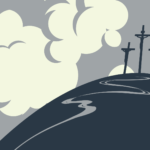Lane Cove Uniting Church will sell its building to build a community that is inclusive, self-regenerating and responsive to need.
Many congregations have made a decision to sell their church property.
The majority of those, however, have done so with the intention of buying another property for the expressed purpose of building a new physical structure in which to continue their ministry and mission.
Not many congregations, suggests the Rev. Dr Jerry Duncan, have had the courage to dispose of their beloved church building to embark on a journey of being the body of Christ in their community in an innovative way.
Dr Duncan, a past minister at Lane Cove Uniting Church and now Presbytery Minister in the Riverina Presbytery, sent his reflections on his time of ministry to be read during Lane Cove’s service of reunion, celebration and thanksgiving on September 30.
Lane Cove believes relationships and community service are more important than buildings and that selling its Finlayson Street property will provide an exciting opportunity to better meet changing needs within the local community.
The congregation plans to offer a full-time minister or lay leader as a chaplain to the Lane Cove community, establish a church community quite different to anything else currently available, and possibly acquire a shop or building near the Lane Cove Plaza to provide support and information for local people.
The chaplain would be available on an ecumenical basis to support people in various situations, help them understand the meaning of life and strengthen their spirituality.
The new church community could be a group of people meeting on a regular or semi-regular basis to discuss spiritual, ethical and topical issues.
Dr Duncan recalled how the Finlayson Street property was developed over the years — from the original church hall to the additions of the kitchen, Sunday school room, the present sanctuary, and the renovations in the late 1980s that provided a new entrance to the church, including offices and a spacious foyer — and thought the service might create a sense of sadness and perhaps even apprehension about the future.
His hope and prayer for Lane Cove Uniting Church was that “you will eagerly and enthusiastically follow new and risky paths with the knowledge that God is going with you.”
The Rev. Geoff Dornan, minister from 1980 to 1982, said the congregation had pursued thinking that at times made people feel uncomfortable and was willing to test the limits.
It represented the best of open-mindedness, where the mission of Christ should lead, he said.
Past, present and future
When the Uniting Church was established in 1977, many people from the former Methodist, Presbyterian and Congregational Churches embraced the opportunity to work together. In Lane Cove, three of the former churches merged to form the Lane Cove Uniting Church:
The Lane Cove Congregational Church was formed in 1878, located at 155 Longueville Road. This is now the site of the Kamilaroi Retirement Centre. The original church building is still on the site.
The Lane Cove Presbyterian Church was formed in 1914 as an offshoot of the Longueville Presbyterian Church. The original church building was demolished in 1993 and a new church building was opened in 1995 as part of the St Columba’s Retirement Centre.
The Lane Cove Methodist Church commenced in a rented hall in 1923 and in 1925 moved to a building on the corner of Finlayson Street and Cox’s Lane. In 1960, a new church building was opened on the same site, with the original building being retained as meeting rooms.
Recent research indicates that much of the Australian population views the Christian Church as being out-of-date, out-of-touch, judgmental and ethically and morally inconsistent.
Institutional religion is eyed with suspicion by a generation that has grown up unfamiliar with the Christian message.
Like many other mainstream churches, the Lane Cove Uniting Church has a traditional approach to worship, an ageing congregation and fewer people attending worship services on a regular basis.
The church has come to the conclusion that significant changes are essential if it is to have a continuing influence in the local community.
The church building on the corner of Finlayson Street and Cox’s Lane has become less than ideal for meeting the needs of the community in the 21st century. The site has limited parking, the location is invisible to most people, access is difficult for older people and people with disabilities; and flexibility with different styles of worship is difficult. Major structural changes would be difficult and expensive, even if they were possible under current regulations.
The section of Finlayson Street, in which the church is located, is now zoned as “high density residential” with plans under way for the construction of a number of blocks of home units.
After careful consideration, the Lane Cove Uniting Church has decided to sell the church site effective from early 2013.
A final service will be held in the Finlayson Street Church at 9 am on Sunday, November 25, 2012. After that, combined services will be held each Sunday at 9 am in the St Columba Church on the corner of Centennial Avenue and Figtree Street, Lane Cove.
Renewed enthusiasm
Some of the Uniting Church’s strengths are its inclusiveness, its acceptance of diversity, its courageousness and its generosity.
The Lane Cove Uniting Church is keen to build a new Christian community that belongs authentically to Australian culture in the 21st century.
Many people are looking for meaning in life and answers to their questions. Many people are seeking spirituality, although not necessarily “religion” or Christianity in the traditional sense.
Priority must be given to the development of relationships and building a community that is inclusive, self-regenerating, responsive to need, spiritual, and open to learning and development.
As well as holding combined services each Sunday in the St Columba Church, the Lane Cove Uniting Church will continue its community service activities with renewed enthusiasm.
Examples include catering for council suppers, supporting people in aged care facilities and providing accommodation for community groups and activities.
Widened horizons
During the service of reunion the Rev. Shirley Maddox spoke about the history of the church on the lower North Shore.
Her connection to the church was through her family, going back to 1929 when she was baptised in the old Lane Cove church and later confirmed and married in it.
Her sister, Dorothy, became the assistant organist when she was 12. The foundation stone of the “new” church was laid by Ms Maddox’s father, Lesley Bowmer, who had been one of the original church trustees.
“What sort of people made up this congregation in those long-ago days in the 1920s and ’30s?” she asked.
“Many were young people like my parents, married immediately after WWI, beginning a family, with a mortgage, living on the edges of this suburb where land and houses were cheaper, but far from family and friends.”
Some were retirees or immigrants from the British Isles, she said.
No-one in that group was wealthy — few were starting up businesses, some worked in retail; the married women were full-time homemakers — yet they set out to grow a congregation in the Wesleyan tradition and persevered through the financial and social risks of the great depression.
Why?
“They did it out of faithfulness to Jesus Christ and the traditions in which they had grown up.
“They replicated the structures of Methodism that had served their parents well and adapted them — cautiously I think — for the new world that was developing around them.
“What did all that mean for the children like me who grew up in the church community they established?
“We heard the Good News about God in worship, in Sunday school, in Christian Endeavour meetings, and in the singing of the choir.”
Ms Maddox said in the Girls’ Comradeship, the Rays and the Order of Knights she and her friends began to learn how to get along together, how to organise activities, how to become leaders, how to run a meeting, how to welcome newcomers.
“And with the excuse of raising money to pay off the church loan we had concerts where older and younger worked together. We sang, played music, recited poems, acted in plays, acted up, and had fun. Out of that came a strong community.
“We met missionaries returning from service in Fiji, Tonga, Samoa and learned that people in those faraway places were not fearsome cannibals but brothers and sisters in Christ.”
She said, “The Rev. A. G. Manefield and his wife opened our eyes to the lives of people in distant parts of New South Wales and the work of ministers in places like Cobar and Bourke and Menindee, who travelled long distances over dirt roads on horseback or in unreliable cars to visit isolated farming families and Aboriginal communities. Out of that my sister Win became part of the Methodist Nursing Service based in Brewarrina, driving long distances in Augustus, a cantankerous ambulance.”
“In that congregation,” she said, “we were kept aware of the needs of poor and disadvantaged people in our city. Out of that we learned to share money and goods, and some of our number became volunteers in the Methodist Mission in South Sydney in the days of the razor gangs and later in Glebe and Darlinghurst.
“We went to youth camps in the country, festivals in Sydney Town Hall, marches of witness. Out of that came widened horizons, wider friendships, the longing to make a difference, and the conviction that we could.
“We began to learn what it meant to live out the gospel in our daily lives.”
She said in the 1920s the founders began the church as witnesses to God in their own place and time.
Now the place had changed: the bush and the trams, the tannery and the market gardens were long gone. The town centre was changing.
The people had changed: now newcomers didn’t come just from the British Isles but from all over the world, speaking many different languages.
“In this time and this place it is clear that being faithful disciples of the Lord Jesus requires more of us than simply replicating the forms of church life that served us well in the past.
“The call to faithful witness in this time and place does not end with the closure of this building.”
Ms Maddox said, “I do not know what making a faithful response to God’s call to faithful witness and service in your own time and place will be like for you. Except that though it will not be easy and will be scary, it can be liberating and fruitful.
“And I trust that as it was for those who began this endeavour here in the 1920s, so you and those who will come after you will be open to the Holy Spirit, alert to the presence of the God who has always been at work in the world — and that you and those who will come after, will move with lively faith, imagination, courage and wisdom into the new future that comes to us all from God’s hand.”
Stephen Webb











